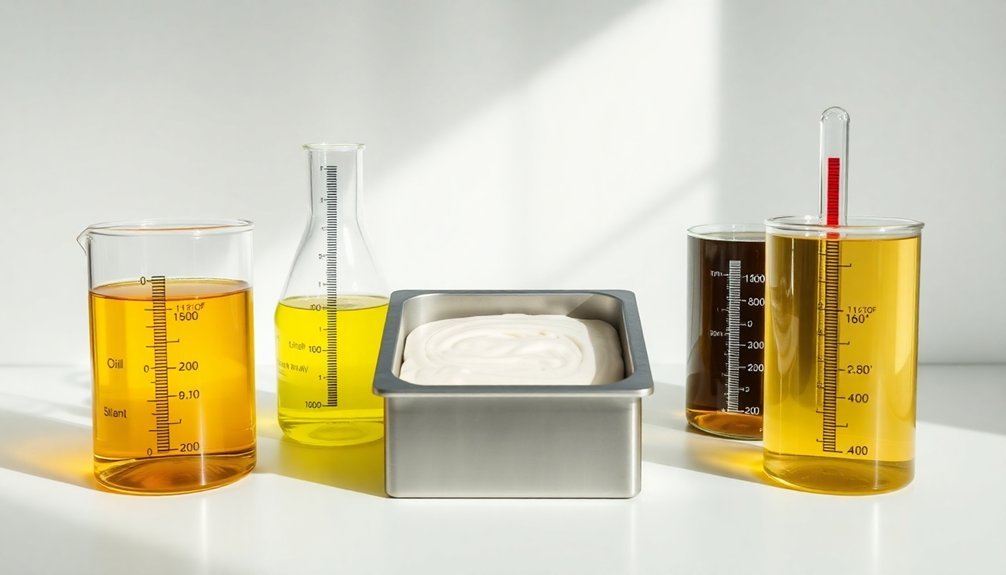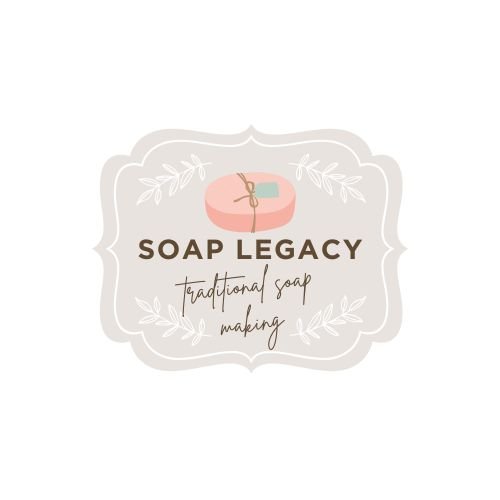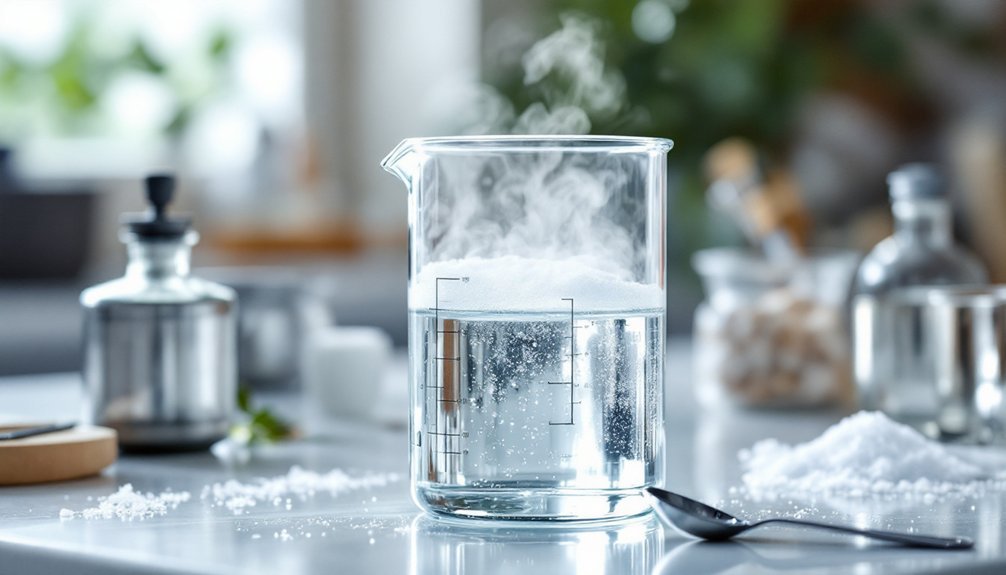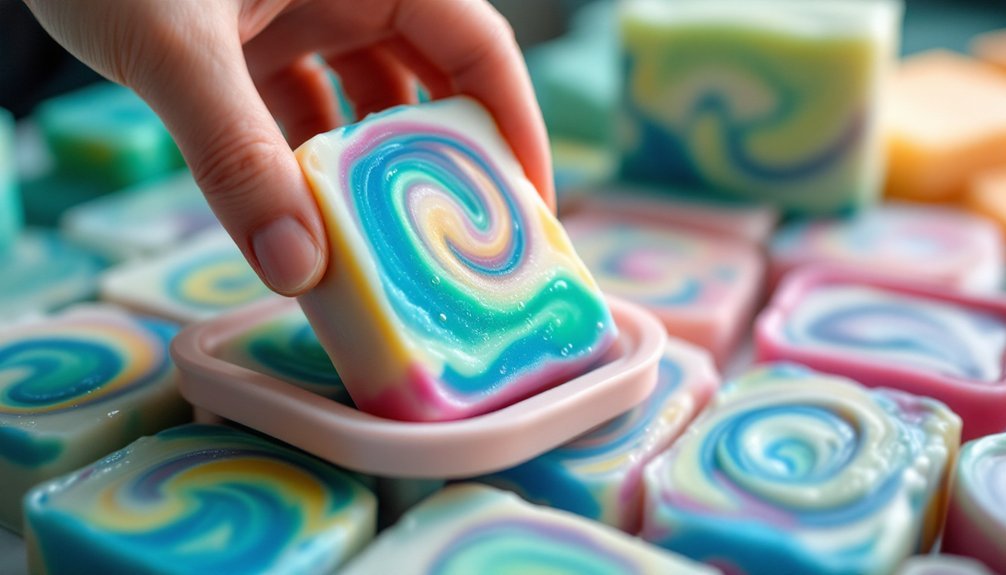The three best oil temperature pairings for soap success are: liquid oils at room temperature (70°F) paired with lye at 100-110°F; hard oils fully melted at 120-130°F then cooled to 100°F with lye at 90-100°F; and mixed oil recipes at 100-110°F combined with lye within 10°F of that temperature. You'll prevent false trace by keeping both components between 90-110°F while ensuring solid oils are completely melted. These temperature strategies guarantee smooth saponification every time.
Optimal Temperature Ranges for Liquid and Solid Oils

When crafting handmade soap, understanding the proper temperature for your oils can make the difference between success and failure. Liquid oils like olive or sunflower work effectively at room temperature (around 70°F), while solid oils require careful attention to their melting points.
For cold process soap making, you'll need to heat coconut oil to 76°F and shea butter to 84°F before introducing your lye solution. To guarantee proper saponification reactions, aim to combine your oils and lye within the 90°F-110°F range.
Hard oils and butters should be fully melted at 120°F-130°F to prevent graininess.
If you're using the heat transfer method, maintain your lye solution at body temperature (98.6°F) to effectively melt moderate oils while helping you avoid false trace issues.
Temperature Pairings to Prevent False Trace in Cold Process
Although experienced soapmakers may experiment with various temperatures, maintaining both your oils and lye solution between 90°F and 110°F is essential to prevent false trace in cold process soap making.
Keep these temperatures within 10 degrees of each other to guarantee proper saponification.
For best results, heat your solid oils to 120°F-130°F first to guarantee they're fully melted, then allow cooling to the target range.
Cloudiness in your oil mixture often indicates insufficient melting, which can lead to false trace.
Consider using the heat transfer method, where your hot lye solution helps melt the oils, promoting even melting and consistent temperatures throughout the batch.
This technique naturally brings both components into the ideal temperature zone, creating perfect conditions for smooth, predictable saponification.
Strategic Heat Management for Different Oil Combinations

Since each oil behaves differently when heated, you'll need to adjust your temperature strategy based on your specific recipe's oil combination. Understanding how to manage temperatures guarantees your soap batter reaches proper emulsion without complications.
- When working with primarily liquid oils, you can start at room temperature (70-75°F) and save yourself unnecessary heating time!
- Solid oils like coconut and palm need temperatures between 76-96°F to fully melt, preventing frustrating false trace issues.
- Recipes with both hard and soft oils work best when your overall oil temperature reaches 120-130°F.
- The heat transfer method is your friend for high liquid oil formulations—let your hot lye solution (around 120°F) do the melting work for you.
- Keep your lye solution and oils within 10°F of each other to avoid dreaded separation during saponification.
Frequently Asked Questions
What Temperature Should Oil Be for Soap Making?
You'll want to heat your oils to between 90°F and 110°F (32°C-43°C) for soap making. This temperature range guarantees proper saponification while preventing false trace or separation during the mixing process.
What Essential Oils Go Well Together in Soap?
You'll find citrus pairs beautifully with grounding cedarwood or patchouli. Try lavender with sandalwood for complexity, or blend floral ylang-ylang with fresh mint. Tea tree and eucalyptus create an effective antibacterial soap with a pleasant aroma.
What Is the Best Temperature to Mix Soap?
You'll want to mix your soap when both oils and lye solution are between 90-110°F. Keep them within 10°F of each other to prevent false trace and guarantee proper saponification for a smooth, successful batch.
What Temperature Do You Add Essential Oils to Soap?
Add essential oils to your soap when the mixture cools to 100-110°F, which is below their flashpoints. You'll preserve their scent and therapeutic properties by adding them at this temperature after reaching trace.
In Summary
By mastering these temperature pairings, you'll avoid the frustration of false trace and soap failures. Remember, it's not just about individual oil temperatures—it's their relationship that matters. Keep your solid oils 10-15°F warmer than liquid oils for balanced reactions, adjust for high-saturated formulas, and you'll consistently create smooth, successful batches. Temperature control isn't just technical—it's your key to soapmaking artistry.





Leave a Reply